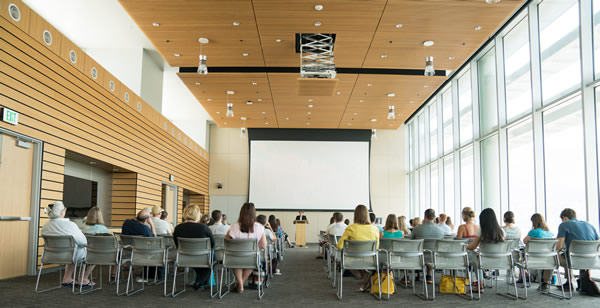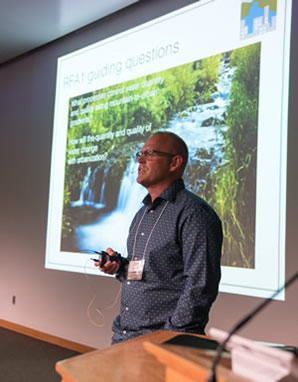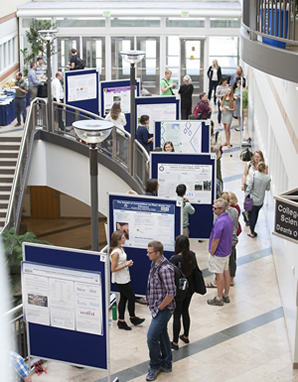News and Highlights
This is a list of past iUTAH EPSCoR news from 2012 to 2018.
October 9, 2017
Local Citizens' Group Discovers Harmful Algal Bloom
Utah Water Watch (UWW) is citizen science program that monitors water quality at 250 sites across the state. As part of a local effort, their help was essential in discovering a recent algal bloom in Mantua Reservoir, located in Box Elder County. During routine monitoring on Aug. 16, they found indicators of cyanobacteria, or blue-green algae, creating conditions that could lead to harmful algal blooms at the site.
Additional tests by UWW on Sept. 8 and 11 indicated increased toxin levels leading the Utah Department of Environmental Quality, Water Division (DEQ) to issue a recreational advisory for Mantua Reservoir in Box Elder County on Sept. 11 advising people to stay out of the water. An article by the Herald Journal reported, “Utah DEQ Communications Director Donna Kemp Spangler said the department works with a lot of different groups to monitor the state’s waters.”
“Our federal, state and local water quality agencies work hard to protect our water, but they have limited resources,” said Nancy Mesner, professor in the Department of Watershed Sciences and an Extension Specialist in Water Quality Extension at Utah State University. Citizen science programs such as Utah Water Watch, a Water Quality Extension program supported by iUTAH, are a popular and effective way of getting people involved in science at a local level.
UWW is especially good at involving local people in water stewardship in their communities. This is especially true with water quality education and monitoring for toxins such as the one discovered in Mantua Reservoir since algal blooms often start with little warning, making early detection difficult. UWW has conducted over 103 training events and trained over 1,025 volunteers since it started in 2012.
“The hundreds of UWW volunteers who monitor local water bodies that they know and love serve as an early warning system,” said Mesner. “They are able to catch cyanobacteria blooms as they first develop, E coli ‘hot spots,’ and other potential water quality problems.”

harmful algal blooms (HABs) and Escherichia coli (E.coli). Credit UWW.
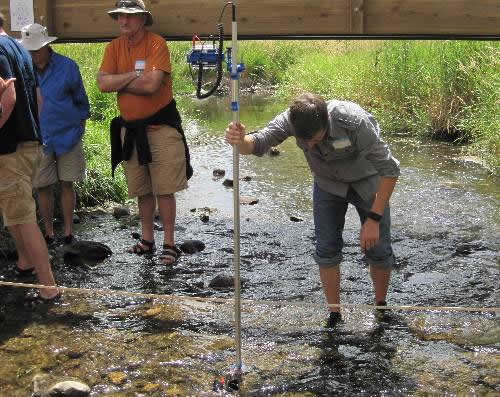
collect high quality data for assessment purposes. Credit UWW.
October 5, 2017
Classroom Lesson Leads to Publication
Former iUTAH postdoctoral researcher Erik Oerter has collaborated with Molly Malone, Louisa Stark, and Gabriel Bowen, and others to publish the paper “Every apple has a voice” in Hydrology and Earth System Sciences, a peer-reviewed open access journal.
In the summer of 2016, Oerter served as a mentor in the Summer Research Institute (SRI), a program supported by iUTAH from 2013 – 2016. The program offered students and teachers the chance to become scientists for one week each summer. He designed a one-day water science activity for the program, including lecture, a hands-on lesson about isotopes, food sourcing, and the water cycle, and a computer lab exercise. Participants, which included high school students, undergraduate students, and high school science teachers, then turned what they learned into a poster presenting their research results.
The effectiveness of the activity was assessed through pre- and post-lesson tests, as well as participant surveys. While the lesson was effective at teaching the basics of stable isotope hydrology and the water cycle, the computer lab needed to be more specifically tailored to each participant’s abilities. Oerter felt that he learned much from the teachers while discussing his lesson. A highlight of the week was “seeing the light bulb go on” in the students as they understand complex concepts while creating their posters.
Oerter is currently working as a postdoctoral researcher at Lawrence Livermore National Laboratory in Livermore, CA. His research focuses on the intersection of hydrology and geochemistry, applying the isotope hydrology expertise gained through iUTAH to a broader set of national issues.
Originally, SRI was designed as part of CI-Water, a prior NSF EPSCoR-funded project that brought collaborating institutions in Utah and Wyoming together to address water issues in the West. Through the guidance of Director Louisa Stark and Senior Education Specialist Molly Malone from the Genetic Science Learning Center at the University of Utah, the program engaged 96 high school students and teachers, and undergraduates in 13 diverse research projects reflecting iUTAH's cross-disciplinary approach over four years.
Full study of the article is available below:
“Every apple has a voice: using stable isotopes to teach about food sourcing and the water cycle.”
Authors: Erik Oerter, Molly Malone, Annie Putman, Dina Drits-Esser, Louisa Stark, and Gabriel Bowen.
Related news article:
Collaborative Paper wins HESS Best Paper Award

Credit: Molly Malone, GSLC/University of Utah
October 5, 2017

The National Science Foundation (NSF) has moved into their new headquarters in Alexandria, Virginia. With the move comes a new address, 2415 Eisenhower Ave, Alexandria, VA 22314, which is just a few steps away from the Eisenhower Avenue metro stop and only a few stops down from Washington National Airport (DCA).
While the physical location has changed, there will be no changes to email addresses and phone numbers for NSF employees and NSF offices. It is recommended that all future NSF visitors and on-site panelists carefully read any instructions and documents sent out prior to visits. And, as always, be sure to have a valid ID that is compliant with the REAL ID Act. If this is not available to you, bring a passport for all future visits to the new building.
September 15, 2017
Publication Features Two Papers on iUTAH Water Science
As the iUTAH project comes to a close, researchers are summarizing methodology and findings as it applies to other water-related research. The September issue of the Journal of the American Water Resources Association (JAWRA) features two in-depth reviews of the mountain urban water system in Utah, specifically, iUTAH design, implementation, and maintenance of sensor equipment, data and metadata produced by the water science project.
The first paper, “Designing and Implementing a Network for Sensing Water Quality and Hydrology across Mountain to Urban Transitions” discusses the logistics of developing and maintaining the Gradients Along Mountain to Urban Transitions (GAMUT) network. The article described the practices followed, as well as insights and findings during the installation and operation of GAMUT. Early on, the research team focused on openly publishing data to drive further science. The research teams “worked to balance scientific needs with physical site limitations, communication constraints, public engagement goals, site security, and partnership potential.” Once the groundwork was laid for the project, additional enhancements focused on quality assurance and system controls to manage and communicate the numerous large datasets produced. The paper finds that GAMUT the "is underlying infrastructure that serves as a vehicle for other research endeavors, ” and instills confidence in consistent long-term data output which secondary users might find helpful after applying their own assessments.
The second paper, “Data Management Dimensions of Social Water Science: The iUTAH Experience” focuses more specifically on integrating a social science framework into the project. It reinforces the first article’s discussion of planning and policy needs, as it explores the open science, data sharing, and the human aspect of Utah’s water system. The study recommends classifying social water science data according to the dimensions of human subject data, primary vs. secondary data, and data restrictions to reveal opportunities and reduce barriers for data sharing. Furthermore, the article concludes by saying that “by facilitating innovative approaches to managing a diverse portfolio of data, the iUTAH program has furthered understanding of a mountain urban water system and provided opportunities for data integration across water sciences and between science and society.”
Full study of each article available below:
Designing and Implementing a Network for Sensing Water Quality and Hydrology across Mountain to Urban Transitions
Authors: Amber Spackman Jones, Zachary T. Aanderud, Jeffery S. Horsburgh, David P. Eiriksson, Dylan Dastrup, Christopher Cox, Scott B. Jones, David R. Bowling, Jonathan Carlisle, Gregory T. Carling, and Michelle A. Baker
Data Management Dimensions of Social Water Science: The iUTAH Experience
Authors: Courtney G. Flint, Amber Spackman Jones, and Jeffery S. Horsburgh
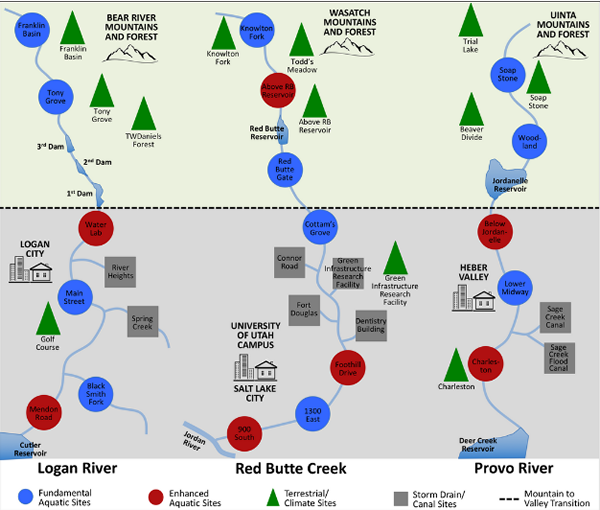
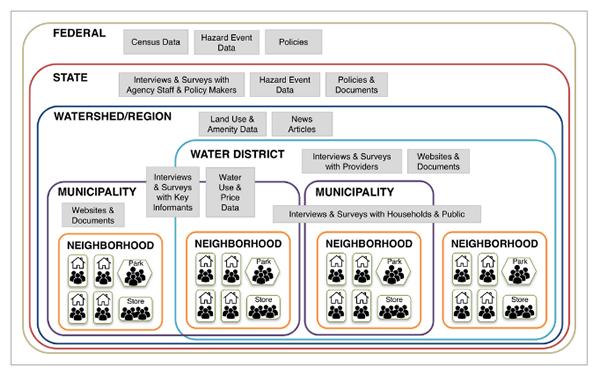
August 28, 2017
Changes in Utah Water Watch Staff
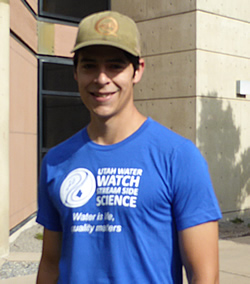
In June, Utah Water Watch (UWW), a Utah State University Water Quality Extension program, said goodbye to co-coordinator Eli Robinson. While working for Utah Water Watch, Eli spearheaded UWW’s Harmful Algal Bloom (HAB) program. This program has been successful in working with citizen monitors to assist the Utah Department of Environmental Quality’s Division of Water Quality in catching HABs before they release toxins and cause potential harm to people and animals. The UWW community will miss Eli’s organizational expertise, sense of humor, and creativity, and wishes him well in the future.
With this change, Cade Andrus has joined UWW as the new co-coordinator. He is a 2017 graduate of the Quinney College of Natural Resources at USU and has a degree in environmental studies along with a strong interest in sustainable development. While in this new position, he hopes to reach a broader audience for water quality education and citizen monitoring. Cade’s diverse background will bring new insights and ideas to the program.
In order to continue supporting and growing programs, UWW has added additional staff this season, including USU students Jose Pacheco, a senior in conservation and restoration ecology, and Hannah Johnson and Cole Patton, who are both incoming freshman and Quinney scholars studying conservation and restoration ecology.
UWW co-coordinator Ellen Bailey, based in Salt Lake City, works with watershed partners to develop advanced monitoring (Tier 2) volunteers in assisting with state monitoring needs, especially in measuring the effectiveness of projects to improve water quality. In her presentation this past July at the iUTAH Symposium, she shared the following numbers on the program’s successes since 2012:
-
103 training events
-
1,025 volunteers trained
-
250 sites monitored overall in Utah
UWW maintains an active citizen science group supporting water stewardship in the state of Utah, including 100 active volunteers this year with 23 specializing in Tier 2 monitoring, and is a program that iUTAH is proud to partner with and support.
August 25, 2017
iUTAH Symposium Celebrates Five Years of Successes
The final iUTAH Annual Symposium and Summer All-Hands meeting was held over two-days, July 13 -14, on the campus of Utah State University in Logan UT. It was a time for reflection, sharing of successes and outcomes, and celebrating five years of collaborative research, training, education, and outreach for Utah’s water future.
Thank you to all the iUTAH EPSCoR collaborators, partners, and friends who joined us as presenters, participants, and celebrants. For those of you that could not be in attendance, we wanted to fill you in on what you missed, along with personal reflections and comments from invited speakers.
Over 120 researchers and educators from universities, municipalities, and governmental agencies, including industry partners and non-profit organizations, came together on the first day to discuss successful water science programs conducted across the state. iUTAH team leaders talked about critical outcomes and lasting impacts in research on water quality and quantity, social and engineered water systems, and modeling and forecasting of future water supply and demand in the state. These updates were followed by short personal experience stories from five active participants whose research or career paths were altered by involvement in the iUTAH project.
Lunch was held in the company of this summer’s iFellow undergraduate researchers who presented posters of their research and answered questions about what they learned. The symposium concluded with 40 talks in seven concurrent sessions on a broad spectrum of topics. It was exciting to hear about the many ways that iUTAH research, education, and outreach has reached the lives of Utahns across the state.
Friday’s all-hands meeting provided a half-day forum for reflection and celebration. Talks from our three invited speakers kicked off with the Head of NSF EPSCoR, Denise Barnes. She listed the project’s many accomplishments, including GAMUT, career catalyst, personal transformations, collaborative capacity, meaningful relationships with state and municipal agencies, and the surveys and social science data— all key components that have been achieved over five years, and are so valuable to Utah. She “encourages the iUTAH team to keep the collaborative momentum going, and continue to build on the project's success,” and closed by saying “you make NSF EPSCoR look good.”
Next, Tami Pyfer, Education Advisor for the Utah Governor’s Office reflected on her experiences growing up with her dad, a Range Scientist and USU alumnus, including research trips to Ekalaka, MT. Pyfer reflected on our project by saying:
“Governor Herbert continually highlights the need to ‘unite and focus’ our efforts to solve problems and improve the lives of the citizens of Utah. The iUTAH project is a perfect example of what can happen when we truly unite and focus on important issues. It exemplifies the collaboration that is happening between education, government and community organizations, as well as the innovation happening within these entities. As a state we are moving more and more toward evidence-based policy making - which is a good thing - and the work of the iUTAH project provides great information and resources that can be used by local and state policymakers.”
The third speaker of the day was Tamara Goetz, Executive Director of the UTAH STEM Action Center, who started her keynote address with a little history, noting that:
"The iUTAH project has been a fun story to watch unfold. When we first found out that we were qualified to become an EPSCoR state, it was met with mixed emotions. There were some who saw it as an opportunity to secure funding for which there were fewer competitors. However, there were others who were dismayed. They felt that it highlighted our inability to secure federal funding and labeled us as a low performing state. Fortunately the desire to collaborate to address a critical issue, such as water management, in our state prevailed. This positive, "can do" attitude is what has made the iUTAH project a success."
Goetz added that:
"I have been impressed with the iUTAH team and their desire to look beyond research and data generation. They made a commitment to look "outward" and engage a larger stakeholder group in the conversation. They brought the issues to the community, creating dialogue around water use and sustainability, through public perceptions studies and public exhibits such as the one at The Leonardo. They were self-reflective and acknowledged that they needed to improve their own public communication skills and worked with groups like the Alan Alda Center for Communicating Science to help researchers do a better job of communicating the value of their work to those that were not directly involved in research."
iUTAH Project Director Michelle Baker challenged everyone in the room to keep the ball rolling, with regards to collaborations and involvement. While the iUTAH project office will no longer host regular All-Hands meetings, she said that we should take every opportunity to organize iUTAH gatherings associated with other events in the state. Two upcoming examples mentioned were the Salt Lake County Watershed Symposium and Weber State University’s Intermountain Sustainability Summit. This message was further reinforced by a pre-recorded video message from university administrators from across the state, prior to the awards and recognition portion of the morning.
In closing, the iUTAH EPSCoR project has been approved for a one-year no cost extension, through July 2018, and looks forward to connecting with each of you and continuing our valuable research, education, training, and outreach collaborations in the coming year. Our website and newsletters will continue to be updated with achievements, happenings, opportunities, and events of interest to our collaborators. We welcome you to stay in touch and continue to let us know what you are doing.
